

Saroj Kumar Datta and Shamindra Nath Sanyal
Traditionally, the goal of “place” in the marketing system is to enable exchange and ensure availability of the right quantity of the right products, at the right place and time, for the right customers/groups. Place strategies either take the products to the customers or drive the customers to the products. Product decisions are made to fulfill the needs, wants, and demands of the consumers who must be provided with the right information and products on demand. Place decisions, on the other hand, involve managing the process to support the flow of goods or services from producers to consumers. The way in which goods flow from the producer to the consumer is the channel of distribution. This chapter presents the variety of channel patterns that exist within economic systems, their tasks, how to manage conflict between channel members and different types of channel intermediation.
A marketing channel has been defined by Panda1 as “a system of relationships existing among businesses that participate in the process of buying and selling products and services.” Channel intermediaries are those organizations that facilitate the distribution of goods to the ultimate customer. The main function of distribution is, therefore, to bridge the gap between the manufacturer/service provider and the customer and to provide value to the customer. Value is what the customers consider worth paying for in monetary terms for the product/service they buy and this is the result of a combined effort of all the activities carried out by the value-chain matrix.2 Since these activities can involve considerable risk and responsibility, it is clear that, in attempting to ensure the availability of their goods, producers must consider the needs of channel intermediaries as well as those of the end consumers.
The distribution environment: As more tasks are assigned to intermediaries, a company producing goods tends to lose control and power over how they are traded. A key part of channel management therefore requires the recognition that networks of intermediaries represent social systems as well as economic ones. Consumers being more rational nowadays are more analysis-prone in their behavior; thus, they are more conscious of quality and price, and they expect more variety of products/services and easy accessibility through the distribution network.
The role of intermediaries in a value chain: The value chain describes the activities involved in the manufacture, marketing, and delivery of a product/service of a firm. Intermediaries perform different functions to bridge Alderson’s Gaps between the producers and the customers (Figure 1). They can reduce time and expenses by decreasing the contacts needed for delivery. Figure 1 shows the number of the required contacts without and with intermediaries (distributors). They can rearrange product ranges from the limited spectrum of a single manufacturer to wider assortments required by the consumers. There are many types of intermediaries but they can broadly be grouped into two categories: retailers and wholesalers.
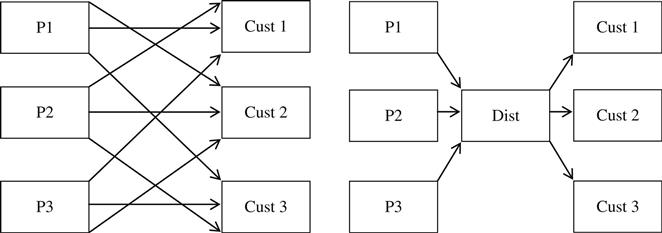
Figure 1: How Using Intermediaries Can Provide Economies. Notes: Without distributor, no. of contacts = (3 × 3) = 9; with distributor, no. contacts = (3 + 3) = 6. P, producer; Cust, customers; Dist, distributor.
Marketing channels are sets of independent organizations involved in the process of making a product or service available for use by the consumers whereas a value network is a system of partnerships and alliances that a firm creates to source, augment and deliver its offerings. The increasing role of information technology (IT) nowadays is to make the value network effective and efficient and thus gain competitive advantage for the organizations. Value addition in the supply chain process can be well understood from the case of the Future Group.
FSC (Future Supply Chain Solutions Ltd.) is the first of its kind: a fully integrated and IT enabled end-to-end supply chain and logistics service provider in India. This value-based service provides services to large corporations in food & FMCG, apparels, footwear and accessories, consumer electronics & hi-technology appliances, automotive, pharmaceuticals, and light engineering domain.
Promoted by Future Group and Fung Capital, FSC has been a pioneer in modernizing supply chain and logistics in a much customized manner by implementing global best practices in the Indian context. This value-based distribution system has enabled FSC to provide customized Supply Chain Solutions & Services which reduce “Time-to-Market” and “Cost-to-Market” of customers. FSC offers two types of service: study of business imperatives of customers and design of customized supply chain solutions in collaboration with the customers and, second, they offer FSC Contract Logistics (Warehousing & Distribution) and FSC Express Logistics (Express transportation services).
Source: www.futuregroup.in
Lele3 proposed a model (Figure 2) by focusing on the changes in purchase pattern of micro (personal) computers and designer apparel through channels at different stages of the product life cycle and suggested how a company should consider market growth rate and value addition by the concerned channel.
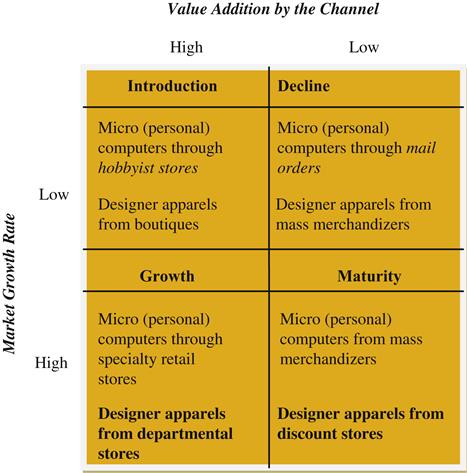
Figure 2: Lele’s Model on the Value Added by the Channel.
Dabur India Ltd., the leading personal and healthcare company and also among top four FMCG companies in India carries a very strong brand equity with Vatika and Real as Superbrands and Hajmola, Real and Dabur as among India’s most admired brands. Having a revenue of more than Rs. 34.2 billion and profits of more than Rs. 5.0 billion in FY 2009–2010, Dabur maintains a very strong distribution channel covering 2.8 million retailers directly and/or indirectly across India. Dabur follows the following distribution network in India (www.dabur.com; www.nseindia.com).
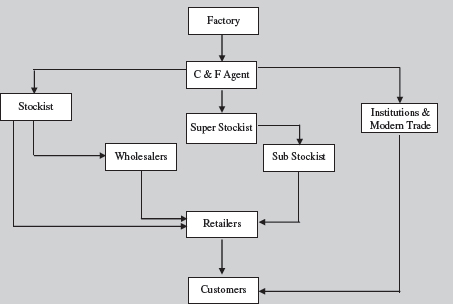
In the absence of any intermediaries the contact between the customers and the manufacturers will become extremely complicated with a nearly uncountable number of manufacturers catering to an infinite number of customers in the present market situation. Hence, the presence of the intermediaries/distributors makes contacts between manufacturers and customers more effective in terms of time, cost, and energy. The channel also provides time utility and place utility of the product/service.
Marketing channel performs two major tasks:
• Ensure smooth flow of goods, services, and information.
• Save manufacturer’s money, time and provide specialized effort.
Distribution channels consist of a set of firms that may or may not be involved in the transfer of title to a product as the product moves from the producer to the ultimate consumer. The producer and the final customer are part of the channel of distribution, which also includes any intermediary such as retailers and wholesalers (Figure 3).
Zero-level channel: Also called Direct Marketing Channel. The shortest, simplest distribution channel of consumer goods involves no intermediary. The producer here may sell door-to-door or by mail. Amway and Eureka Forbes are classic examples of this kind.
One-level channel: Many large retailers buy directly from manufacturers and sell to the consumers. Companies who are running their business via their exclusive retail stores can also be termed as one-level channel, for example, in India, Bata, Raymonds follow one-level channel system.
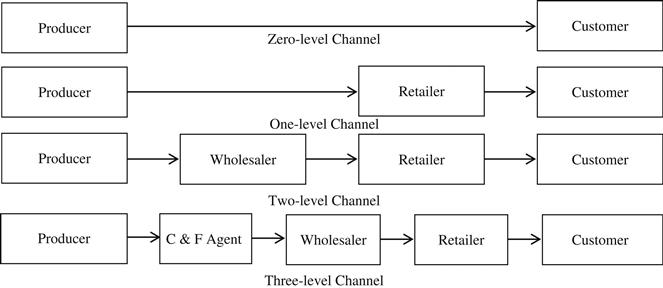
Figure 3: Marketing Channel for Consumer Market.
Two-level channel: This is a traditional channel for consumer goods with two intermediaries. This is also economically a feasible choice for a large number of small retailers and manufacturers. ITC runs the distribution of its Classmate and Papercraft brands through two-level channels in urban and sub-urban areas. Most of the FMCG companies and pharmaceutical companies are running through this system.
Three-level channel: In this case the wholesalers take the help of jobbers who sell to small retailers. The jobbers may add some value to the product in terms of packaging or assembling, etc. ITC runs the distribution of its Classmate and Papercraft brands through three-level channels in rural areas.
A variety of channels are available to reach organizations that incorporate the products into their manufacturing process or use them in their operations. In the distribution of business goods, the terms industrial distributor and merchant wholesalers are synonymous (Figure 4).
Zero-level channel: This direct channel accounts for a greater volume (in terms of money) of business product’s than any other distribution structure. Manufacturers of large installation, such as filtering machine in petrochemicals, cooling towers, generators, etc. usually sell directly to the users.
One-level channel: Producers of supplies and small accessory equipment frequently use industrial distributors to reach the markets. Companies manufacturing industrial tools, for example, small operating devices, hand tools, multi-usage tool kits, etc. generally operate through this mode.
Two-level channel: Firms without their own sales department or those who wants to introduce enter a new market may prefer to use agents. For example, US-based Stake Fastener Company operates through this mode.4
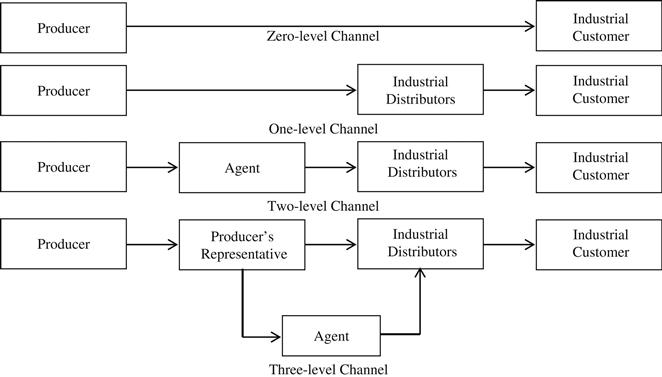
Figure 4: Marketing Channels for Industrial Markets.
Three-level channel: A producer can use its sales force or it can sell through its agents to reach business customer either through an industrial distributor or directly to the market. For example, US-based Hartman Electric run through this system.4
The nature and intensity of the competition in a particular industry generally determine the distribution pattern adopted by a company.
Intensive distribution: It consists of the manufacturer placing the goods or services in as many outlets as possible. This distribution does not offer any control of the company on distribution outlets. These products are used routinely and frequently and they require no after sales service.
Selective distribution: This approach is the so-called middle path approach to distributing products. Here, the company selects some outlets to distribute its products and the distributors can keep products of few limited number of producers, and generally of one category of products. It is used by established companies and by new companies seeking distribution. Selective distribution can help the producer achieve optimum market coverage.
Exclusive distribution: In this approach, the producer sells its goods through a limited number of outlets and maintains the exclusive availability of its own brands and not the competitors’. Here, the distributor has an exclusive relationship with the producer and is not allowed to keep competitors’ products and brands. It is used when the producer wants to severely limit the number of intermediaries and wants to maintain control over the service levels and outputs offered by the resellers.
Khadim’s India Ltd. Has a pan India retail presence in footwear and other leatherwear segments marked by owned outlets, exclusive dealers supported by other selective and even intensive distribution networks. Khadim’s has its own exclusive stores across the country. All these stores maintain the same décor and interiors so that the customers have the same feel. Khadim’s maintains other exclusive dealers spread across the country. An exclusive dealer purchases its entire product requirement from Khadim’s and sells the products at the same MRP. These outlets carry the name Khadim’s and maintain the same décor and interiors. Khadim’s also has certain selective distribution networks who mainly deal with the Khadim’s products apart from other brands. They procure the products directly from Khadim’s. Apart from these, there are several outlets spread across India who regularly purchase and resell Khadim’s brands by following the intensive distribution network.
Source: www.khadims.com
Distribution channels are very dynamic in nature. The recent developments are as follows:
Vertical marketing systems (VMS): A vertical marketing system (VMS) is one in which the main members of a distribution channel — producer, wholesaler, and retailer work together as a unified group in order to meet consumer needs. There are three types of VMS:
• A Corporate VMS which combines successive stages of production and distribution under single ownership. Vertical integration is accomplished through forward or backward integration.
• An Administered VMS coordinates successive stages of production and distribution through the size and power of one of the members. One member emerges as dominant in the channel. Brand leaders or market leaders in a certain product category practice trade cooperation through this system.
• A Contractual VMS consists of independent firms at different levels of production and distribution integrating their programs on a contractual basis to obtain more economies than they could achieve alone. For example
1. Wholesaler-sponsored voluntary chains
2. Retailer cooperatives
3. Franchisee organizations.
To understand the three types of VMS, let us look at what ITC Ltd. has done with its strategic business units.
ITC Ltd., owner of some of the very big brands in India, runs its business process by following the aforesaid dynamics of the marketing channels. ITC Ltd. is famous for its different strategic business units like FMCG, hotels, paperboard & specialty papers, packaging, agribusiness, and information technology. ITC runs its lifestyle brand “Wills Lifestyle” through exclusive retail stores or corporate vertical marketing systems. Since ITC is the unanimous market leader in the tobacco segment, it enjoys the administered VMS among the numerous tobacco sellers across India. Wills Lifestyle, apart from running their exclusive retail stores, has started invading tier 2 and 3 cities by opening up stores under franchisee model, that is, under contractual VMS line.
Horizontal marketing systems (HMS): Horizontal marketing system is a merger of firms on the same level in order to pursue marketing opportunities. By working together, companies can combine their capital, production capabilities, or marketing resources to achieve more than any one company could alone. Companies might join forces with competitors or non-competitors. They might work with each other on a temporary or permanent basis, or they may create a separate company.
Multichannel marketing systems (MMS): When a single firm uses two or more marketing channels to reach one or more customer segments. This channel system is known as hybrid channel or multichannel. The advantages are increased coverage, lower cost, and customized selling. The case of TVC Skyshop will focus on the exclusivity of the multichannel marketing system.
TVC Skyshop. Established in 2000, “TVC Skyshop” is India’s leading multichannel direct-to-consumer (DTC) virtual marketing retailer with multiple platforms like print media, direct response television programs, Internet and catalogues with 5 million customers. TVC Skyshop has been a pioneer since its inception with a differentiated strategy of marketing its own brands, primarily in the categories of consumer electronics and wellness goods. The herbal range of products offered by the company is manufactured in its own pharma grade manufacturing unit in Himachal Pradesh. TVC has a unique distribution model with pan India penetration using 600 exclusive distribution partners and having the ability to deliver products in over 3500 towns across 17,000 PIN codes. It was established by Vinod Agarwal and funded by Samara Capital.
TVC Skyshop is the only player which markets and distributes 100% branded products across consumer categories such as books, magazines, electronics, mobiles, accessories, apparels, home furnishing, toys & games, jewelry, and home appliances with substantially higher margins.
Source: yourstory.com
There will be some conflict between channel members, even if they are well-designed and managed. The simple reason for this is that the interests of independent business entities do not always coincide. Conflict also derives from goal incompatibility, unclear roles, differences in perception and over-dependence of one party on another.
• Vertical channel conflict: Conflict between different levels within the same channel.
• Horizontal channel conflict: Conflict between members at the same level within the channel.
• Multichannel-level conflict: Conflict takes place when the middlemen come in conflict with the producer, using both direct and indirect ways of distribution.
Some channel conflicts can be constructive and such conflicts may lead to more dynamic adaptation to a changing environment. Hence, the objective is not to eliminate conflict but to manage it better or minimize it. There are several mechanisms for effective conflict management:
• Adoption of super ordinate goals: Channel members come to an agreement on the fundamental goal they are jointly seeking, whether it is survival, market share, high quality or customer satisfaction.
• Frequent communications: Frequent communications between producer and channel members can minimize the possibilities of further conflict.
• Exchange of people between channel levels can partially resolve conflicts.
• Co-option: This can be done by including the leaders of another organization in advisory councils, the Board of Directors, etc.
• Mediation and arbitration: When the conflict becomes serious and/or other efforts are not successful, each side sends a person or group to meet with its counterpart to resolve the conflict. In mediation they resort to a neutral third party who is skilled in resolving the conflict by safeguarding the two party’s interests. In arbitration both parties agree to present their arguments to one or more arbitrators and accept the arbitration decision unanimously.
The word “retail” is derived from the French word “retaillier” which means to cut a price off or to break a bulk. In simple terms retailing includes all the activities involved in selling or renting consumer products and services directly to customers for their consumption.
Retailing involves a direct connection with customers and coordination of business activities from end to end — right from the concept of the product or the design stage of an offering to its successful delivery and post-delivery service to the customers.
In general, the retail establishments can be classified as follows:
Specialty store: Narrow product line with a deep assortment. A clothing store would be a single-line store; a men’s clothing is a limited-line store; and a men’s custom-shirt would be a super specialty store. Bata, Reebok, Tanishq are some important specialty stores in India.
Department store: Large-scale retailing organizations that offer a broad and deep assortment of offerings. Several product lines — typically clothing, home furnishings, and household goods — with each line operated as a separate department managed by specialist merchandizers. It also provides a wide variety of customer service facilities. For example, Pantaloons and Shoppers Stop.
Supermarket: These are large and self-servicing retail formats that offer a wide variety of merchandize to a large customer base. By maintaining relatively low-cost with low-margin and minimum customer service, supermarkets offer the benefits of large product assortments in a single location with comfort, convenience, and variety. Big Bazaar, Spencer’s, and Reliance Fresh are some of the examples of supermarkets in India, whereas Tesco (UK) and Carrefour (France) are noteworthy international supermarkets.
Discount store: This retailer maintains standard merchandize sold at lower prices with lower margins and higher volume combined with the reduced costs of operating the business. The attributes of this type of store are that they offer a broad assortment of products but with little depth, predominantly offering low price and very limited customer service. For example, Vishal Garments.
Convenience store: This type of retail store is relatively small and generally located near residential areas. They have long hour of transactions and are open generally seven days a week. They also offer a limited line of high-turnover convenience products at slightly higher prices.
Big retail stores that are owned by a corporate group in contrast to smaller version of retail stores that are independent or locally owned. Corporate retailing is also known as organized retailing. The major types of corporate retailing include corporate chain stores, voluntary chains, retailer cooperatives, franchisees, and merchandizing conglomerates.
Corporate chain store: Two or more outlets commonly owned and controlled by a company employing central buying and merchandizing, and selling similar lines of merchandize. Their size and financial back-up allow them to buy in large quantities at lower prices. They can afford to hire specialists deal with pricing, promotion, merchandizing, category management, inventory control, and sales forecasting.
Voluntary chain: A wholesaler-sponsored group of independent retailers engaged in bulk purchase and common merchandizing.
Retailer cooperative: Independent retailers who set up a central buying organization and conduct joint promotion efforts. The member retailers get the same advantages that large chains and corporate have in their business operations.
Franchisee organization: Contractual agreement between the producers and the retailers-selling the producer’s products exclusively. Franchisees are independent business people who buy the right to own and operate one or more units in the franchisee system and sell the producer’s product exclusively. Franchising has been prominent in numerous product and service areas. Examples: McDonald’s, Pizza Hut, KFC, ITZCASH.
This includes all the activities involved in selling goods to those who buy for business use. Wholesaling generally excludes those engaged in production, farmers growing agricultural outputs, and retailers. However, large retailers often accept functions handled by the wholesalers. The growing trend of non-store retailing or e-commerce is making the operation easier for producers and consumers.
• Selling and promoting
• Buying and assortment building
• Bulk breaking
• Warehousing
• Transportation
• Financing
• Risk bearing
• Market information
• Management service and counseling.
• Merchant wholesalers: Independently owned businesses that take title to the merchandize they handle and take risks allied to their ownership and conventionally purchase and resell assortments to industrial or retail consumers. They are also called jobbers or distributors and fall into two categories: Full-Service Merchant Wholesalers and Limited Service Merchant Wholesalers.
• Brokers and agents: They form the second major category of wholesalers. They do not take title to goods and perform only a few functions. Their main function is to facilitate buying and selling on a commission basis, generally based on the product price. They do not carry inventory or do financing. Brokers are employed to represent buyers or sellers on a temporary basis. Agents represent buyers or sellers mainly on a permanent basis.
• Manufacturers’ sales branches and offices: In this case, the wholesaling operations are conducted by the separate branches and offices of the manufacturer, which are dedicated to sales and purchasing. They get involved in inventory management. Sales branches carry inventory and provide necessary support services to manufacturer’s sales force, mainly in those areas where a considerable number of customers are present and demand is high. Sales offices do not carry inventory and operate like the sales branches.
Physical distribution of organizations starts at the factory and ends with the customer. Supply chain management (SCM) is a wider concept that starts before physical distribution and involves procuring the correct inputs, converting them efficiently into finished products and dispatching them to the final customers. A company works through a valued network that includes suppliers, supplier’s supplier, immediate customers, and their end customers. SCM involves planning the infrastructure to satisfy demand, implementing and manipulating the physical flows of materials and final goods from point of origin to the customer points, while generating an excess.
Market logistics planning follows four steps:
• Deciding on the company’s value proposition to its customers.
• Deciding on the best channel design and network strategy for reaching the customers.
• Developing operational excellence in sales forecasting, warehouse management, transportation management, and materials management.
• Implementing the solution with the best information systems, equipment, policies, and procedures.
Supply chain management decisions involve four major decisions:
• Order processing: How order should be handled? Increasingly it is being observed the use of information technology to help order-processing functions.
• Warehousing and materials handling: Where stocks should be located? The type of warehouse depends on the type of product: tangible or digital and perishable or not.
• Inventory management: How much stock should be held to balance responsiveness to meet customer demands with the available resources necessary to store inventory.
• Transportation and delivery: Where stocks should be finally sent? It is considered to be the most important function in logistics.
Inventory cost increases at a very high rate as the customer service-level approaches 100%. Order-processing cost per unit goes down as larger quantities are ordered and hence, less frequently an order needs to be placed. Higher transportation costs may be considered (e.g., using air cargo) as long as total system costs (inventory, warehousing, etc.) are lowered.
CASE: INTEGRATED MARKETING CHANNELS
DTDC India
Saroj Kumar Datta
Shamindra Nath Sanyal
DTDC is India’s largest courier and cargo delivery network, comprising of over 5300 channel partners across the country with a workforce of 22,000 people, promising deliveries of 11 million consignments per month, and covering over 10,000 PIN codes in India. It was started in 1990 by an entrepreneur Mr. Subhasish Chakraborty. This organization is headquartered in Bangalore. During 1990 Chakraborty realized that there was a major gap in express distribution services to the B2B and B2C market structures in India and latent need for providing express delivery services. His war-footing to exploit this opportunity created an express courier company and Desk to Desk Courier and Cargo was born on July 26th, 1990. Today DTDC also has a noteworthy global business and it serves 240 international locations, including the United States, the United Kingdom, Canada, the UAE, Hong Kong, Australia, China, and the ASEAN countries through its own operations, joint ventures and business associates. With a very strong product that addresses all logistics-related needs of its clients, ranging from Express Documents to Heavy Cargo, from Domestic Premium Products to International Delivery, and from Supply Chain Solutions to Warehousing, DTDC aspires to be India’s most preferred end-to-end Logistics, Express and Retail Services conglomerate with comprehensive global reach, by 2020.
The endeavor that was begun as a concept in 1990, soon gained impetus across industries and today DTDC has the largest network in the country in the private sector with over 5345 franchisees working 24 × 7 across the country. This innovative concept of express delivery has been effectively carried overseas, with DTDC franchisees appointed in the United States, the United Kingdom, the UAE, and Singapore, despite the market dominance of brands like FedEx or DHL. This model has been so successful that now it has traversed the Indian shores and attracted other service delivery industries as well. Moreover, this business model has also become the case study at various business schools in India and abroad.
The unique selling proposition (USP) of the brand DTDC and the factors responsible for its fast worldwide growth are mainly having the largest infrastructure network, biggest domestic brand in express courier industry, state-of-the-art IT infrastructure, largest deliverables through multimodal transport facilities, special premium products like time-bound delivery, Sunday/holiday delivery and money back guarantee, information in real-time basis for all national and international deliveries, 22,000 people handling over 10 million parcels a month, zero-debt organization, only Indian courier company having implemented SAP-ERP and ISO 9001:2008, full range service from documents to truck loads, domestic and international, separate dedicated Supply Chain Solutions Divisions dealing in warehousing, logistics, and transportation.
Being short of working capital Chakraborty devised a unique business model of appointing franchisees, who would not only strengthen the network at minimal capital investment, but also generate business opportunities for themselves, as well as for DTDC. This was a win-win arrangement and it became the cornerstone for DTDC’s success story. DTDC pioneered the “Franchisee Business Model” in the courier & cargo industry in India. The “Franchisee Business Model” initiated the first mover advantage in terms of reaching customers, which was a key requirement and also the major USP for DTDC.
According to Mr. Suresh Bansal, Director, Supply Chain Solutions and International Business DTDC Ltd., as of now 5345 franchisees are present throughout India. The company is aiming to expand the network to 10,000 franchisees in the next few years. Any individual aspiring to become an entrepreneur and having the capacity to invest in minimum infrastructure will be eligible for getting appointed as a franchisee. Based on the investment and operationalization of business, there are three categories of franchisee as follows:
– Total investment: Category A: Rs. 1,50,000, Category B: Rs. 1,00,000, Category C: Rs. 75,000
– Area required: Category A: 300 sq. ft., Category B: 200 sq. ft., Category C: 75 sq. ft.
– Preferred location: Ground floor, preferably facing the main road
– Return on investment: 30%
– Expected break-even time: four months for A category, six months for B category, and nine months for C category.
Source: dtdc.com; www.franchiseindia.com
1. Analyze the major issues in the case. Has the time come to rethink the business model of DTDC?
2. What objectives and constraints have compelled Chakraborty to shape his channel decisions? If you were a consultant, what alternative distribution channel strategy would you recommend Chakraborty for domestic and overseas markets?
With a very strong offering DTDC aspires to be India’s most preferred end-to-end Logistics, Express and Retail Services conglomerate with comprehensive global reach, by 2020. Following a model of express delivery through franchisees, DTDC Ltd. is aiming to expand the network to 10,000 franchisees.
Since the present model is doing exceptionally well and generating good growth in Indian as well as foreign markets, the DTDC management should continue with the same business model.
During 1990 Chakraborty realized that there was a major gap in express distribution services to the B2B and B2C market structures in India and latent need for providing express delivery services. His war-footing to exploit this opportunity created an express courier company and Desk to Desk Courier and Cargo was born on July 26th, 1990.
For the second part of the question, the student should be asked to propose any channel management model that can best be described as the alternative to the present model of DTDC.
Learning objectives
The following objectives can be devised for the case study:
(a) To understand the dominant perspectives on entrepreneurship.
(b) To have an experiential learning idea about a special business model, which might also be effective for other e-commerce companies.
(c) To have an understanding about the strategy formulation to cope with the situational constraints.
(a) Analysis of Subhasish Chakraborty’s entrepreneurial characteristics like functional, motivational, and expertise in the field and how these parameters support his venture.
(b) Analysis of the success story and the customers’ about the different courses and the implications for designing and operating the new ventures of MBA and BBA courses.
(c) Consideration of the objectives and constraints that have compelled Chakraborty to shape his channel decisions.
Evaluating the alternative distribution channel strategy, if any, for domestic and overseas markets.